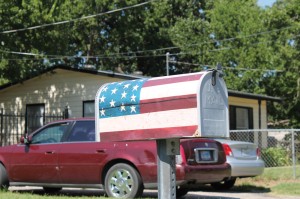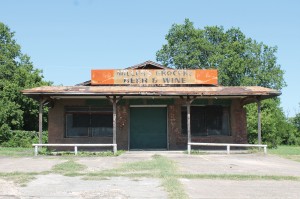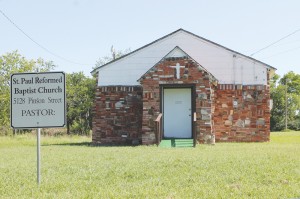
Blair, who grew up in Stop Six in the 1970s and ’80s, said the neighborhood was a “wonderful” place to live, with little crime and a community that was like a family. Blair’s mother worked at a nearby restaurant that Blair describes as a hot spot for conversation and social gatherings. But by the time Blair returned in 2003, crime had run rampant, with shots fired regularly and drugs dealt rather openly on street corners.
The next time Blair and Duncan met, in 2003, it was to form the constitution and bylaws for the Stop Six: Sunrise Edition Neighborhood Association.
“There were so many people who had been in the shadows saying, ‘Thank you. We’ve always wanted our voice to be heard. We wanted to participate in planning our community,’ ” Blair recalled.
Blair believes the need for improvement expedited the founding process –– in three months, the Stop Six: Sunrise Edition Neighborhood Association was born.
Association members soon realized they could not clean up their surroundings without financial and economic assistance from the city. For the next three years, the neighborhood association put together presentations, requests, and petitions to capture the city’s attention and inspire the City Council to vote in favor of granting the neighborhood a historic designation.
But the historical designation was “doomed to fail,” Blair said. Typically, roadblocks took the form of ineffective conversations with city staff and little warning from the council when Stop Six-related items were scheduled for voting.
Without their historic designation, Blair said, neighborhood association members and other concerned residents were forced to take care of the neighborhood themselves once again –– and at their own expense.
“These policy changes would [have left] our community ineligible for existing city urban-village funding,” she said, referring to the development plan that focuses on medium-density housing, mixed zoning, and improved pedestrian and public space, “and ineligible to access state or federal grants that could assist us as a [nonprofit organization] with historic preservation efforts.”
Stop Six: Sunrise Edition earned its historic district designation in 2007. Finally.
But Blair believes the designation didn’t get the chance to help because Blair believes City Council had no interest in it and the lack of communication was preventing anything meaningful from being done.
This is the first time the city has moved to dedesignate a historic district, said Planning and Development Director Randel Harwood.
“This is a very rare occurrence,” Harwood said. “I don’t think we’ve ever dedesignated a historic district.”
Part of what made the historic designation appealing, Blair said, was the opportunity for city investment, as well as the potential for homeowners to apply for tax incentives for living in historic buildings. Without these funding opportunities, Blair now worries that her neighborhood will no longer be able to afford repairs, making preservation almost impossible.
However, the historic district designation may not have been removed –– officially. There is more red tape to cut through before Stop Six: Sunrise Edition looses the designation, said Liz Casso, an officer with the Historic Preservation Office, a department within Fort Worth Planning and Development.
After the June 28 City Council vote, Casso said the city asked a presiding officer to discuss the matter with the Historic Landmark Commission. The officer was instructed to gather further information on the condition of the neighborhood. On July 11, the council requested the Landmarks Commission to assess the area and submit a recommendation based on observations on whether Stop Six: Sunrise Edition historically contributes to the historic district, a neighborhood or broader geographic area with historic designation such as Historic Fairmount or Historic Carver Heights.
A report by the Landmarks Commission was filed that same day, stating that in the fall of 2015 the district was surveyed, and it was found that 312 of the 982 lots (or 32 percent) contributed to the historic district, while 670 (68 percent) did not. In the report, commission members noted that 45 percent of the non-contributing lots were vacant.
“New reports are still being made,” Casso said, adding that city staff “is gathering information,” which will be presented to the Historic Landmark Commission in a public meeting on August 8.
From there, the recommendation will move through the zoning commission, before, finally, it is presented to the City Council for a final vote.
*****

Stop Six is represented in City Council by Gyna Bivens –– a name often mentioned among the members of the Stop Six: Sunrise Edition Neighborhood Association. That is especially true for Regina Blair.
Initially, Blair said she believed Bivens would stand by the historic designation and fight to make the locals’ voices heard. She said the opposite is true, adding that when the neighborhood association is left out of negotiations with developers, locals get ignored. Blair said she believes the councilmember stands to gain from increasing development in Stop Six.
Bivens called Blair’s accusations “irresponsible,” saying there are strict policies in place to prevent her from benefitting from projects.
After Donovon Wheatfall left the City Council in 2008, Blair said his successors have consistently ignored the neighborhood association’s wishes and rarely –– if ever –– agreed to meet with the group.
Bivens and Blair both acknowledge that Bivens has held community meetings at Sweet Home Baptist Church, a building located about a block north of Ramey Avenue. Blair added that since she has never received a notice about these meetings, and since Bivens has not met with the Stop Six: Sunrise Edition Neighborhood Association directly, the councilmember does not have accurate information on the community’s views regarding designation.
“Whatever info [Bivens is] getting is second-hand,” Blair said. “She has refused to meet with us.”
Bivens, when asked about her feelings about the neighborhood association, merely said she gauges her success by her victorious 2013 run for the District 5 council seat, not by her relationship with Blair’s group.
“What I look at is the margin of victory that I had – I think I had the biggest margin of victory compared to anybody [else] on the council –– 87 percent,” Bivens said, accidentally inflating the actual number, according to Ballotpedia.org, by .06 of a percentage point. “That’s the real indicator of my relationship with the neighborhood.”
Bivens, who lives in Stop Six, said she wants to improve the area and inspire others to move there.
In a CBS 11 interview earlier this year, Bivens made a controversial comparison of Stop Six, saying, “With that historic overlay, it looks like a Vietnam war zone.”
Her statement caused outrage among neighborhood association members.
“That’s a weighted statement,” Blair said, arguing that such a description paints an offensive picture for viewers who may have never visited to the area.
“White people don’t come to this side of town, so they’re going to take that as fact,” Blair said.
Blair went on to point out that war zones are not usually considered appealing sites for developers.
However, Bivens said Stop Six itself is not appealing to developers either.
The Secretary of the Interior’s Standards and Guidelines for Archeological and Historic Preservation state that historic buildings and districts are to be preserved with as little additional development as possible. Development of these areas is limited to maintenance and repairs for safety reasons, leaving the historic integrity of the district intact, preserving the area’s historic appearance. Aesthetic guidelines for existing structures must then be applied to any additional development, be it commercial property or a residence.
These restrictions make Stop Six an economic wasteland, Bivens argued in our interview, discouraging developers from building there. This was in contrast to other historic districts in Fort Worth, she said, which have often shown an economic boost after receiving designation.
“When a community gets that historic district designation, you see improvements coming,” she said, “you see property values increasing … . That hasn’t happened in Stop Six, and it’s been almost 10 years.”
Planning and Development’s Harwood said he believes the plan to dedesignate will go through to the deciding City Council vote partly because of Bivens’ staunch support.
“My sense is the councilmember will support it all the way through,” he said.
Harwood said he trusts Bivens’ word that the area no longer contributes to the city historically, but he said further proof is required before the city can fully gauge whether that is the case.
“We don’t have any proof or evidence of that, because we haven’t had the resources enough to go out and do more than a windshield survey,” he said.
A windshield survey is when city staff members drive through a neighborhood and compare existing structures to previous aerial shots of the properties.
Blair said she and fellow association members are also concerned about the growing number of rental properties being built and the decrease in home ownership in the neighborhood.

Stop Six is no stranger to rental properties –– in fact, Blair said the abundance of renters and abandoned homes is likely responsible for City Council’s support for dedesignating historic Stop Six: Sunrise Edition. The council recently stated that a nearly 85-percent majority of petitioned residents voted against the historic designation. Councilmembers applied the original designation petition, from 2006, as evidence.
Blair believes the council came to this conclusion due to home vacancies and the difficulty that her group had in reaching renters.
“What you find is vacant lots, boarded-up houses,” Blair said. “You can’t contact those people. You don’t know where they are. You mail the information, and it comes back not signed.”
Many of these properties were rental properties, she said.
“Most of the ones that we did mail and that didn’t come back –– they were rental properties,” Blair said.
She added that rental developers likely do not have an interest in the wellbeing of a neighborhood, looking for money first and community-building last. Neighborhood association members see this preference for development as detrimental to their aim to restore historic Stop Six: Sunrise Edition.
“As a community, without the assistance of our government, how are we supposed to do that?” she asked.
In 2005, two years before the historic designation was granted, the group had a plan to finance rebuilding and painting projects throughout the area. That plan came to a confusing end in 2011, and for the neighborhood association, the reasons behind it remain a mystery.
******












God bless you Ms Blair, keep on pushing. You’re truly doing God’s work. Thank you very much.
I’m trying to do better…what’s the problem with the above remark?
Who do I need to pay to get moderated???